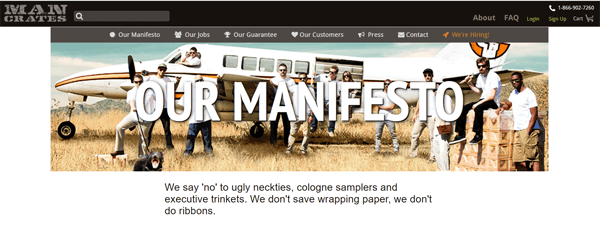Five Critical Site Elements to Impact a Customer's Journey

Success online requires a deft combination of the efficiency of online shopping with the warmth of our favorite in-store shopping experiences. Websites can seem unfriendly, untrustworthy and confusing. As such, the brands that can deliver a well-designed customer journey are best positioned to build trust, and convert browsers into shoppers.
In this article we explore five of the most critical site elements in your customer's journey, using online retail examples to see how we can create a more engaging experience that drives conversion.
Lead with strong branding
Your website is a vehicle for defining your brand. Delivering on that with strong, consistent messaging acts as a site differentiator. It's better to offer a specific message that reaches and engages your target audience rather than fail trying to appeal to everyone.Take ManCrates, for example. Built as a retailer of gifts for the "manly" man, its bold and unapologetic branding remains consistent throughout the entire customer journey. The company has a deep understanding of its customer, and the site's copy, imagery and personality clearly reflect that.

Most site visitors aren't immediately ready to purchase. In fact, the average conversion rates for ecommerce fall between 2-3 percent according to our data. Creating a memorable site experience will leave a lasting impression that encourages visitors in the browsing phase to return in the future to purchase.
Make it easy for customers to find your products
The ease with which customers can locate your product makes a huge difference in conversion. Physical stores separate products by category and use signage to direct customers to the right area. Defining the dairy aisle is the difference between running into a store to quickly grab a pint of milk and wandering aimlessly before leaving empty handed.Website navigation should be similar. Sites like The Knobs Company not only sort products by area of the home, but also break it down further to sort by use case. If, for example, you are looking to renovate a bathroom, its website divides the bath category by robe hooks, curtain rods, drawer organizers, etc. Need specific cabinet hardware? There's a category for that too.

A thorough search functionality is also a must. Using keywords and meta data tags mean that customers can find what they are looking for both on, and off, your site. But The Knobs Company takes search a step further by allowing visitors to search by an uploaded image, which helps visitors navigate the site when they're not sure what they're looking for.
Build trust with descriptive product pages
When shopping in-store, consumers have the ability to experience a product before committing to purchase. The heft, quality and size are all immediately obvious to us when holding an item in our hand. Without that tactile experience, online consumers must rely on accurate imagery, product descriptions and even customer reviews to inform their decisions.For ecommerce brands, breaking through this virtual barrier presents a challenge. Bring your product to life with unique, informative product descriptions and beautiful, realistic images to compel a customer to buy. This means knowing your target audience and using descriptions that speak to their specific needs. Additionally, offering size guides and product videos can help address any concerns customers have about buying a product they haven't seen in person.
Native Union, for example, delivers beautiful product imagery for a commoditized product: phone chargers. Its attention to detail, along with contextual hints on size and quality (look at that leather wrap!), clearly indicate what the product will look like, instilling a sense of confidence in curious shoppers.

Customer reviews also build trust on product pages. StoreYourBoard encourages customers to leave on-site reviews and real-life imagery to give potential customers a clear idea of how each product would work in their space. The site has more than 2,000 product reviews and 1,300 user-submitted Q&A responses. The result? User engagement has driven an increase in sales and StoreYourBoard found that 25 percent of customers who submit a question end up making a purchase.

Be responsive with mobile-friendly sites
Customer journeys don't always happen the way you might expect. Online shoppers are not always searching for products on their desktop computer with their credit card in hand. Realistically, over 50 percent of traffic will come to your site via mobile (20 percent of customers have even admitted to shopping while in the bathroom or the car!) according to a BigCommerce study.Non-responsive sites create a frustrating navigation experience for customers and frequently lead to site abandonment, which is why Google is increasingly penalizing poor site experiences with lower search rankings.
In today's mobile-first world, it's just not acceptable to maintain a site that does not look great on all devices. Not to mention, the tools offered through many ecommerce platforms today enable merchants to build a fully-responsive, beautiful online storefront without requiring the skills of a developer. What was once available to only the largest retailers is now accessible for sites of all sizes, ensuring that everyone has the ability to provide a superior site experience wherever their customers are.
Complete the purchase with a frictionless shopping cart
It's no surprise that providing a safe and secure place for customers to checkout is one of the most crucial elements of an ecommerce site. Even more critical is ensuring that once a customer decides to buy, nothing prevents them from completing that purchase, and this includes a complex or time-consuming checkout process.Think about an in-store shopping experience: have you ever been on the way to checkout only to surreptitiously discard your items somewhere near the front of the store because the queue was too long? The same holds true for online shopping. If the ecommerce checkout process is too long or confusing, you'll see increased cart abandonment rates.
A streamlined checkout includes a preview of the number of steps remaining, confirmation of the products purchased, accurate shipping costs and easy ways to pay. Modern ecommerce platforms offer digital wallets like Amazon Pay, PayPal and Apple Pay that allow for one-touch buying. Reducing the friction involved in entering payment information is especially critical for customers shopping on mobile devices where small screens and limited time can make paying troublesome. In a recent Nielsen study, offering digital wallets and alternative payment options like PayPal improved conversion up to 44 percent.
Why not now?
Ignoring any of these critical site elements will dramatically impact your customer's journey, and your bottom line. Even the most beautiful, well-designed storefront will suffer if customers don't feel comfortable engaging with and shopping on the site.
Here's the good news: upgrading these site elements doesn't have to be time consuming or expensive, especially if you can find an ecommerce platform that provides this robust functionality out-of-the-box. A little focus on the big elements goes a long way - and that means you can reinvest time saved from building your website into growing your business, quickly.
About the Author

Deniz Ibrahim serves as principal, product marketing at BigCommerce, where he is focused on the company's international expansion efforts, as well as introducing new pricing, storefront and checkout features to BigCommerce merchants. He has more than a decade of experience in a variety of product and marketing roles, and has previously held positions at American Express and Seamless.







